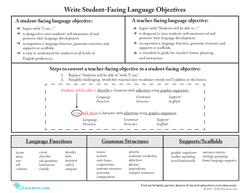- Worksheets
- Games
- Lesson Plans
- Workbooks
- Exercises
- Science Projects
- Skills Progression
- More
You are here:
Lesson Plan
Exploring Nonstandard Units of Length
Encourage your students to develop their own approach to measuring length with nonstandard units of length. Use this engaging lesson as a stand-alone lesson or alongside Measuring Feet...in Feet!
Grade
Subject
View aligned standards
Objectives
Academic
Students will be able to measure using nonstandard units of length.
Language
Students will be able to describe the height of a peer with grade-level academic vocabulary, using nonstandard units of length and sentence frames for support.
Introduction
(4 minutes)- Explain to the students that one of your family members has offered to purchase new number lines for student desks. Tell the students that the number lines come in many different lengths and your family member wants to know the length of the desks so they can purchase a number line that will fit the length of the desk, from end to end, and not be too big or too small for the desk. Point from the end to end of the desk to help students understand the meaning of length.
- Ask students to think-pair-share how you could figure out the length of the desk and provide a sentence frame to support student discussion. An example sentence frame would be:
- You can use ________ to figure out the length of the desk.
- Allow a few students to share out their ideas with the rest of the class. Use prompting questions like:
- How do we usually measure things?
- Are there different ways to measure things?
- Are there different tools we can use to measure things?
- Why is it important to measure something before we make a purchase?
- Share an example of a time when a family member or friend purchased something that was too big or too small. Ask students if they can think of any examples of a time when a family member purchased something that was too big or too small. Students may share examples such as furniture that doesn't fit throught the door of their house, clothing that was too big or too small, etc. Have students share their answer with an elbow partner.
- Explain to the students that today you wil be measuring using nonstandard units of length. Tell the students that this means you'll be using objects to measure things instead of rulers or a tape measure!



